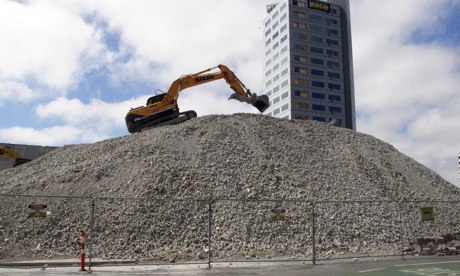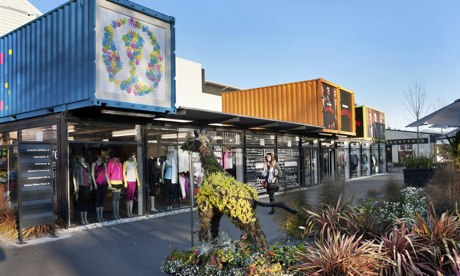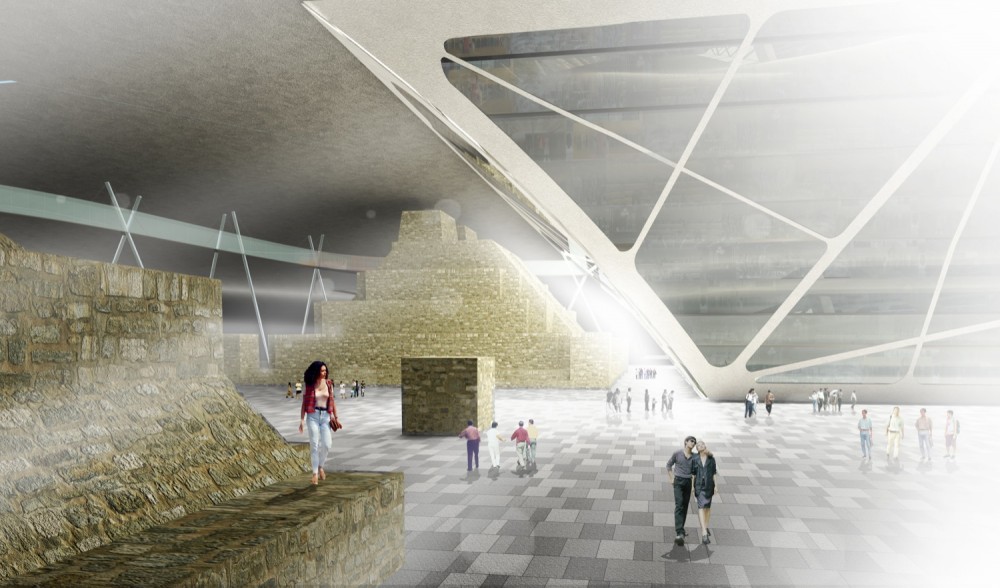A recent international visitor to New Zealand‘s second largest city asked Coralie Winn why there were so many diggers in its centre tearing down buildings. It seemed they had little notion that less than three years earlier, Christchurch had endured a series of earthquakes that destroyed the city’s infrastructure, homes and communities.

The most violent quake, on 22 February 2011, killed 181 people. Thousands more were made homeless, and an area more than four times the size of London’s Hyde Park was deemed uninhabitable. Less than three years on, the diggers that rattle about Christchurch’s gridded streets are a constant reminder of how far there is to go to recreate what was once there. “People don’t comprehend,” Winn said. “Rebuilding a city is complicated.”
In the wake of the earthquake, Winn helped found an organisation devoted to creatively inhabiting the vacant gaps where those buildings once stood. Gaps are expected to keep opening up for at least another five years, as 70% of the central business district’s (CBD) buildings come down.
Many locals cannot remember what the central city used to look like. Gravel quadrants have replaced multi-storey buildings, creating lines of sight through the city that never existed before. Many of the buildings that still stand are boarded up, with steel fencing around them as they wait to be sold or demolished. The main strip of bars and restaurants that lined the river, and was the site of the city’s main entertainment hub, is now an empty lot.

Until recently, you could look through the dusty windows of a closed down cafe and still see an untouched 22 February 2011 edition of the local newspaper. And while creative novelties such as a retail mall made entirely out of steel shipping containers draw increasing numbers of visitors, the city’s other main attraction is the battered and broken cathedral in the middle of the main square – a monument to what was endured.
From our partners:
The new Christchurch, which is being marketed as “greener, more compact, more accessible and safer”, will cost in the region of NZ$40bn (£20.3bn) – almost 20% of New Zealand’s annual GDP. In the immediate aftermath of the earthquake, central government moved to triage the most important parts of a functioning city. Infrastructure like roads and bridges had been shattered. Silt that had bubbled up from the earth clogged sewerage systems. Powerlines were down. Homes were without working toilets for weeks, sometimes months.
The government’s response was to establish a single body, the Canterbury Earthquake Recovery Authority (CERA). It was solely responsible for managing the rebuild. “If you look around the world at cities which have experienced disasters, it is single-purpose organisations that are the most efficient,” said CERA’s chief executive, Roger Sutton. This one was tasked with managing the complete project – from the demolition of commercial buildings and residential homes to planning the next phase of rebuilding. In the early period, almost 8,000 of the area’s 180,000 homes were “red zoned”, meaning land was so badly damaged that it was unlikely it could ever be rebuilt on. A further 9,100 properties were reckoned to be uninhabitable because they required such major repairs. From June 2010 to June 2012, the population for the greater Christchurch area declined by 9,200 (2%).
Where do we go now?
In times of crisis, Sutton said, it is better to be 90% right and get a message out quickly than 99% right and issue it slowly. The risk to this strategy, however, is that the missing 9% comes back to bite you. In some instances, it has. There have been protests over the way CERA has handled the red zoning of residential areas. Last November, some homeowners living in the city’s hills were told their properties were too dangerous to inhabit – after being told the contrary for more than a year. Many saw this as an example of top-down leadership gone wrong.

The city’s mayor, Lianne Dalziel, hopes to usher in a new era of governance that focuses on empowering community organisations to do things for themselves. “Building a resilient city starts at the grassroots, so that bottom-up meets top-down halfway,” she wrote recently.
The ability to plan for, absorb, recover from and adapt to events is surely key to becoming a more resilient city. At a conference on “resilient futures”, which was held in the city soon after the earthquake, Massey University’s Prof Bruce Glavovic, the country’s top recovery expert, criticised the purely top-down approach. “How is [CERA] going to capitalise on local culture and knowledge? How is it going to mobilise local capacity to rebuild? How is it going to enable local communities to make choices that will build safer and more sustainable communities?” he asked.
Despite such sentiment, a division of CERA was tasked with developing the city’s first urban blueprint plan. Taking in 106,000 ideas from across the community, it was launched in July 2012 after a 100-day deadline. “We want this city to be distinctive with an active urban edge,” said the division’s general manager, Don Miskell. A team of local and international architects and designers created the plan, which involved 70 projects being constructed over the next 20 years. It imagined a compact central business district dominated by low-rise buildings. A “green frame” around the CBD would blend in with the Avon river that was being developed as a corridor of parkland through the city. It also emphasised environmentally sensitive transport, including a new light rail network, pedestrian boardwalks and cycle lanes.

Before the earthquakes, the centre’s retail areas were not competing well against the rise of suburban malls: “It was clear,” Miskell said, “the rebuild following the 2011 earthquake provided a great opportunity to make Christchurch better than it ever was.” But some have questioned parts of that vision. While certain building codes had been changed to include height restrictions, there was no legislation to enforce building “greener”. Sir Mark Solomon, the head of the local Maori tribe Ngai Tahu, recently remarked that the rebuild had not put enough emphasis on sustainability. “It was certainly one of my visions that we would adopt full green technology across the city,” he told a televised panel discussion. “But if you go through the subdivisions – including our own – it’s the same old, same old.”
There is still debate about what Christchurch should become. The earthquake recovery minister, Gerry Brownlee, has suggested that the region’s sporting heritage makes it a perfect location to become a world leading sports hub, with state-of-the-art facilities and stadia. But at grassroots level, some feel this idea is too narrow and does not represent the greater Christchurch.
Care of the community
“Unless people in communities understand what is happening and can relate that to their own situation, there can be a sense of anger and frustration,” said community organiser Evan Smith, whose own house was red-zoned soon after the February quake. Smith advocates a return to “village values”, with the city being made up of many smaller residential areas. “One thing the earthquake taught us is that you can’t always rely on central services to survive,” he said. “You have to rely on things within walking distance, without a car or a laptop. If you build with that in mind, you build in a lot of resilience.”
With precisely this in mind, dozens of community organisations, manned by people like Smith, popped up after the earthquake. They became the voice of people on the ground while government attempted to gain an overall picture of the disaster (often the information that government had and the reality depicted by these organisations were vastly different).

These were the seeds of what Smith hoped would become more of a participatory democracy. Furthermore, he said, the opportunity to rebuild on the basis of the best modern urban planning (as opposed to the city’s previous grid system, which evolved without a great deal of control) also throws up exciting possibilities. “Very few have the opportunity to do that retrospectively. It’s the one shot and we have to get it right.”
Smith is working on a proposal to turn the entire 11km (7 mile) red zone along the Avon river into an ecological and recreational reserve for the community. It will turn a “scar on the landscape” into a source of hope for the city, he said.
Coralie Winn’s temporary projects have also helped spur that hope. Restaurant areas, innercity dancefloors and music sites, she said, have all encouraged a creative rethink about what makes up a vibrant and resilient city. “We’d really like to see more of an intersection between the blueprint style and the temporary,” Winn added. “They both need to one another and work together.”
In the meantime, tourists with high-powered digital cameras stop and stare at machinery continuously tearing down buildings. More recently, though, another trend has emerged: tourists are also watching with curiosity as more and more buildings slowly go up.
This article is from 100 Resilient Cities.













